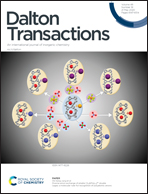Covalent and ionic bonding in bi- and tricyclic Group 15 amides: equidistant P–I and As–I bonds and fluxional cations†
Abstract
A series of trivalent Group 15 bis(tert-butylamido)cyclodiphosph(III)azane element bi- and tricycles of the formulae {[(tBuNP)2(tBuN)2]ElX}, El = P, As, Sb, Bi, where X = Ph, OPh, OtBu, N3, hexamethyldisilylamide (HMDS), OTf, was synthesized from the corresponding chlorides via salt elimination. The ensuing compounds were studied spectroscopically and X-ray crystallographically with a particular focus on the length of the El–X bond. While the Group 15 element to phenyl and HMDS were of normal lengths and completely covalent, those to azide appeared to be partly ionic. The {[(tBuNP)2(tBuN)2]ElI} showed El–I bonds that were substantially longer than the typical element iodide bonds, suggesting a very high degree of polarity and bordering on ionic bonding. Finally, the triflate [(tBuNP)2(tBuN)2]P] + [SO3CF3]− proved to be an ion pair in the solid state. The antimony analog, however, showed a long covalent Sb–O bond in the solid state, although it appears to dissociate into ions in solution. The phosphonium triflate salt is fluxional and exhibits a previously unseen highly symmetrical structure in solution. The bonding trends from completely covalent to completely ionic are discussed in terms steric restrictions and the delocalization of charge in either the cation or the anion.



 Please wait while we load your content...
Please wait while we load your content...
